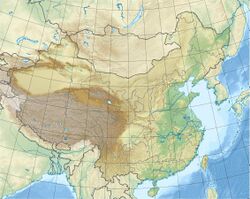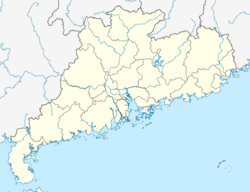Earth:Nanxiong Formation
| Nanxiong Formation Stratigraphic range: Maastrichtian 66.7 Ma | |
|---|---|
| Type | Geological formation |
| Underlies | Shanghu Formation |
| Overlies | Jurassic granite basement, Changba Formation (Nanxiong Group) |
| Thickness | ~300 m (980 ft) Several kilometers (Nanxiong Group) |
| Lithology | |
| Primary | Sandstone, siltstone, mudstone |
| Other | Limestone, conglomerate |
| Location | |
| Coordinates | [ ⚑ ] : 23°30′N 114°54′E / 23.5°N 114.9°E |
| Paleocoordinates | [ ⚑ ] 23°48′N 110°30′E / 23.8°N 110.5°E |
| Region | Jiangxi Province, Guangdong Province |
| Country | China |
| Extent | Nanxiong Basin |
The Nanxiong Formation (also known as Yuanpu Formation) is a Late Cretaceous geologic formation in Jiangxi and Guangdong Provinces. Dinosaur remains are among the fossils that have been recovered from the formation.
Description
It consists of continental siliciclastic red beds, with fauna which similar to that of the Nemegt Formation. It has been dated to about 66.7 ± 0.3 million years ago.[1] It is the lowest unit of the Nanxiong Basin, a small graben created during Mesozoic rifting.[2] Buck et al. state that it overlies Jurassic granite basement, and is conformably overlain by the Shanghu Formation.[1] Alternative stratigraphic schemes for the Nanxiong basin have been proposed,[3] one of which refers to the Nanxiong succession as the Nanxiong Group, and dividing it into the Yuanpu, Zhutian and Zhenshui formations, and overlying the Albian to Turonian Changba Formation.[4]

The Depositional environment is made up of alluvial fan facies consisting of sheetflood deposits and ephemeral braided rivers. Adjacent to these are ephemeral saline playa facies recording features such as; root traces, desiccation cracks, and calcareous paleosols. In situ desert varnish and minor paleosol development on alluvial facies due to inactivity are indicative of arid conditions. Stable carbon and oxygen isotopes from Dinosaur eggshells were used to estimate a mean annual temperature between 22–27.6 °C (71.6–81.7 °F), with positive isotope perturbations around the K/Pg boundary indicating periods where temperatures may have exceeded 27 °C (81 °F).[5][6][1]
Paleobiota of the Nanxiong Formation
Template:Paleobiota-key-compact
Crocodilians
| Crocodilians | ||||||
|---|---|---|---|---|---|---|
| Genus | Species | Material | Notes | Images | ||
| Jiangxisuchus[7] | J. nankangensis | Nearly complete skull and mandible | A crocodyloid |  | ||
Lizards
| Lizards | ||||||
|---|---|---|---|---|---|---|
| Genus | Species | Material | Notes | Images | ||
| Chianghsia[8] | C. nankangensis | A partial skull and lower jaws | A monstersaurian lizard | |||
| Tianyusaurus[9] | T. zhengi | A skull, mandible, first eight cervical vertebrae and nearly complete pectoral girdles | A polyglyphanodontian lizard, also known from the Qiupa Formation |  | ||
Turtles
| Turtles | ||||||
|---|---|---|---|---|---|---|
| Genus | Species | Material | Notes | Images | ||
| Jiangxichelys[10] | J. ganzhouensis | A complete shell | A nanhsiungchelyid turtle | |||
| Nanhsiungchelys[11] | N. wuchingensis | A partial skeleton | A nanhsiungchelyid turtle[12] | |||
| Oolithes[13][12] | O. elongatus, O. nanhsiungensis, O. rugustus and O. spheroides. | Egg and egg clutches. Some of these were probably laid by Nanhsiungchelys.[13][12] | Turtle and/or theropod eggs | 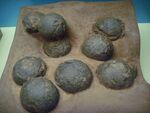 | ||
Dinosaurs
Ornithischians
| Ornithischians of the Nanxiong Formation | ||||||
|---|---|---|---|---|---|---|
| Genus | Species | Material | Notes | Images | ||
| Microhadrosaurus[13] | M. nanshiungensis | Partial lower jaw from a juvenile that was about 2.6 m long | A nomen dubium hadrosaur taxon.[4] | |||
| Hadrosauropodus isp.[4] | Indeterminate | Three-toed footprints[4] | A hadrosaur | |||
| Nodosauridae indet.[14] | Indeterminate | Osteoderms | A possible nodosaurid ankylosaur | |||
Sauropods
| Sauropods of the Nanxiong Formation | ||||||
|---|---|---|---|---|---|---|
| Genus | Species | Material | Notes | Images | ||
| Gannansaurus[15] | G. sinensis | A single, nearly complete dorsal vertebra and a mid-caudal vertebra | A sauropod closely related to Euhelopus |
 | ||
| Jiangxititan[16] | J. ganzhouensis | The three posteriormost cervical vertebrae with two cervical ribs, articulated with the first four dorsal vertebrae with three dorsal ribs | A somphospondylan of controversial affinities; originally described as a derived lognkosaurian titanosaur, later analyses recovered a more basal, non-titanosaurian position more likely.[17] |  | ||
Theropods
Oviraptorosaurs
| Oviraptorosaurs of the Nanxiong Formation | ||||||
|---|---|---|---|---|---|---|
| Genus | Species | Material | Notes | Images | ||
| Banji[18] | B. long | Nearly complete skull and lower jaw | An oviraptorid |  | ||
| Corythoraptor[19] | C. jacobsi | Nearly complete skeleton including the skull and lower jaw | An oviraptorid with a distinct cassowary-like crest | 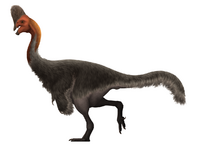 | ||
| Elongatoolithidae indet. | Indeterminate | Three eggs with embryonic remains.[20] | Oviraptorid eggs | 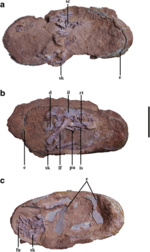 | ||
| Ganzhousaurus[21] | G. nankangensis | Lower jaw, leg bone, hip bone and caudal vertebrae | A transitional oviraptorid with both basal and derived traits | 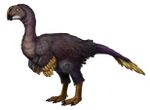 | ||
| Huanansaurus[22] | H. ganzhouensis | Nearly complete skull, lower jaws, neck vertebrae, a humerus, arm fragments, lower part of the right thighbone, the upper part of the right shinbone, and parts of the right foot | An oviraptorid |  | ||
| Jiangxisaurus[23] | J. ganzhouensis | Incomplete skull, lower jaw, vertebrae, nearly complete pectoral girdle, the left forelimb, ribs, and a partially preserved pelvic girdle | An oviraptorid |  | ||
| Macroolithus | Indeterminate | Five egg clutches containing over 60 eggs.[24] | Oviraptorid eggs | 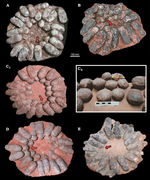 | ||
| Indeterminate | Three eggs with embryonic remains.[25] | Oviraptorid eggs | 150px | |||
| M. yaotunensis | Two eggs with embryonic remains.[26] | Oviraptorid eggs. Skeletal proportions resemble Heyuannia huangi | ||||
| M. yaotunensis | A nest of 24 eggs associated with an adult oviraptorid.[27] | Oviraptorid eggs | ||||
| Nankangia[28] | N. jiangxiensis | A partial lower jaw, vertebrae, both scapulocoracoids, a nearly complete right humerus, pubic bones, and some dorsal ribs | An oviraptorid | 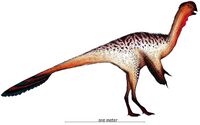 | ||
|
Oviraptoridae indet. |
Indeterminate | A female individual preserving the pelvic girdle, some caudals and two eggs inside the abdominal cavity.[29] | A pregnant oviraptorid | |||
| Indeterminate | A nesting adult over a nest of eggs, preserving cervical vertebrae, arms and the pelvic region.[27] | An oviraptorid that represents the fifth nesting taxon | ||||
| Indeterminate | A female individual preserving a partial pelvic girdle, hindlimbs and some caudals with two eggs associated near the pelvic region.[30] | A pregnant oviraptorid | ||||
| Shixinggia[31] | S. oblita | Sparse postcranial remains lacking the skull | An oviraptorid | |||
| Tongtianlong[32] | T. limosus | Almost complete skeleton, portions of the arms, right leg, and tail were destroyed by TNT blasts | An oviraptorid, the pose indicates that it may have died trying to free itself from mud | 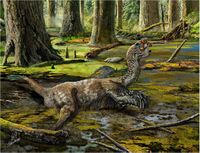 | ||
| Therizinosaurs of the Nanxiong Formation | ||||||
|---|---|---|---|---|---|---|
| Genus | Species | Material | Notes | Images | ||
| Nanshiungosaurus | N. brevispinus | Eleven cervical vertebrae, ten dorsal vertebrae, six sacral vertebrae and the pelvis.[13][33] | A therizinosaurid |  | ||
Tyrannosaurs
| Tyrannosaurs of the Nanxiong Formation | ||||||
|---|---|---|---|---|---|---|
| Genus | Species | Material | Notes | Images | ||
| Asiatyrannus[34] | A. xui | A skull, partial legs, and fragmentary caudal vertebrae | A small-bodied tyrannosaurine |  | ||
| Qianzhousaurus[35] | Q. sinensis | A skull, lower jaw, vertebrae, both scapulocoracoids, a left femur and a left tibia | A tyrannosaurid, could represent a third species of Alioramus[36] |  | ||
|
Tyrannosauridae indet. |
Indeterminate | Two isolated teeth.[13] | A tyrannosaurid | |||
| Indeterminate | Large and well-preserved tooth.[37] | A tyrannosaurid | ||||
Other Theropods
| Genus | Species | Material | Notes | Images |
|---|---|---|---|---|
|
Theropoda indet. |
Indeterminate | A maxillary tooth that differs from tyrannosaurid and carcharodontosaurid dentition.[37] | A notably large theropod | |
| Indeterminate | Isolated dorsal vertebra.[13] | A theropod |
See also
- List of dinosaur-bearing rock formations
- Dalangshan Formation
References
- ↑ 1.0 1.1 1.2 Buck, B. J.; Hanson, A. D.; Hengst, R. A.; Shu-sheng, H. (2004). ""Tertiary Dinosaurs" in the Nanxiong Basin, Southern China, Are Reworked from the Cretaceous". The Journal of Geology 112 (1): 111–118. doi:10.1086/379695. Bibcode: 2004JG....112..111B. https://www.researchgate.net/publication/215605299.
- ↑ Lucas, Spencer G.; Kirkland, James I.; Estep, John W. (1998). "Vertebrate biostratigraphy and biochronology of the Cretaceous of China" (in en). Lower and Middle Cretaceous Terrestrial Ecosystems: Bulletin 14. New Mexico Museum of Natural History and Science. p. 14. https://books.google.com/books?id=yF4fCgAAQBAJ&q=nanxiong+formation&pg=PA14.
- ↑ Yan, Yi; Xia, Bin; Lin, Ge; Cui, Xuejun; Hu, Xiaoqiong; Yan, Pin; Zhang, Faqiang (April 2007). "Geochemistry of the sedimentary rocks from the Nanxiong Basin, South China and implications for provenance, paleoenvironment and paleoclimate at the K/T boundary". Sedimentary Geology 197 (1–2): 127–140. doi:10.1016/j.sedgeo.2006.09.004. ISSN 0037-0738. Bibcode: 2007SedG..197..127Y. https://d1wqtxts1xzle7.cloudfront.net/33882154/1%E7%BB%88%E7%A8%BFSEDGEO3727.pdf?1402014267=&response-content-disposition=inline%3B+filename%3DGeochemistry_of_the_sedimentary_rocks_fr.pdf&Expires=1595373478&Signature=PUW2lmHY2SBo1vo~HuFe59lkzKQDnnPoz3XexKD6a-9Rh75RiJJ25FjkA-3cYLXhZvhzUMnC87Vh0lTNSZ1W6feAcnfuHBzxXn-NMepfjObNwkicoLrGl97~2BgSD9VwViLFJSJBHEJU9h0CU6wLOHgnRptoZ9a4-A4YeEycnmdSAr6-3~KQ8t~PjeRzXx5~zv86JCq0VawqusN36uKMZEmWr~G2b~K6H3wn91fuTk4sZFdpVexYnHDXF3fym8Hx0htV3gNJvkCJVXFypX65cKz0Yhplonas6B6S9BUbONEiP5FPC8bmYSyrmu4Ozy-Ao98CqwFh4Y090-ocdzu7FQ__&Key-Pair-Id=APKAJLOHF5GGSLRBV4ZA.
- ↑ 4.0 4.1 4.2 4.3 Xing, L.; Lockley, M. G.; Li, D.; Klein, H.; Ye, Y.; Scott Persons IV, W.; Ran, H. (2017). "Late Cretaceous ornithopod-dominated, theropod, and pterosaur track assemblages from the Nanxiong Basin, China: New discoveries, ichnotaxonomy, and paleoecology". Palaeogeography, Palaeoclimatology, Palaeoecology 466: 303−313. doi:10.1016/j.palaeo.2016.11.035. Bibcode: 2017PPP...466..303X. http://www.xinglida.net/pdf/Xing%20et%20al%202017%20Nanxiong%20tracks.pdf.
- ↑ Zhao, Zikui; Yan, Zheng (2000-02-01). "Stable isotopic studies of dinosaur eggshells from the Nanxiong Basin, South China" (in en). Science in China Series D: Earth Sciences 43 (1): 84–92. doi:10.1007/BF02877833. ISSN 1862-2801. Bibcode: 2000ScChD..43...84Z.
- ↑ Liu, Yun; Wang, Zongzhe (1990). "Uppermost Cretaceous and Lowest Tertiary Strata in the Nanxiong Basin of Guangdong with Reference to Their Petrographic Characters and Sedimentary Environment". in Lu, Yanhao (in en). Palaeontologia Cathayana. 5. Berlin, Heidelberg: Springer. pp. 295–309. doi:10.1007/978-3-662-12662-2_13. ISBN 978-3-662-12662-2. https://link.springer.com/chapter/10.1007/978-3-662-12662-2_13.
- ↑ Chun Li; Xiao-chun Wu; Scott Rufolo (2018). "A new crocodyloid (Eusuchia: Crocodylia) from the Upper Cretaceous of China". Cretaceous Research 94: 25–39. doi:10.1016/j.cretres.2018.09.015.
- ↑ Mo, J. Y.; Xu, X.; Evans, S. E. (2012). "A large predatory lizard (Platynota, Squamata) from the Late Cretaceous of South China". Journal of Systematic Palaeontology 10 (2): 333. doi:10.1080/14772019.2011.588254. Bibcode: 2012JSPal..10..333M.
- ↑ Jun-chang Lü; Shu-an Ji; Zhi-ming Dong; Xiao-chun Wu (2008). "An Upper Cretaceous lizard with a lower temporal arcade". Naturwissenschaften 95 (7): 663–669. doi:10.1007/s00114-008-0364-1. PMID 18338150. Bibcode: 2008NW.....95..663L.
- ↑ Haiyan Tong; Jinyou Mo (2010). "Jiangxichelys, a new nanhsiungchelyid turtle from the Late Cretaceous of Ganzhou, Jiangxi Province, China". Geological Magazine 147 (6): 981–986. doi:10.1017/S0016756810000671. Bibcode: 2010GeoM..147..981T. http://www.foreignpolicybulletinmonitor.com/action/displayAbstract?fromPage=online&aid=7908884&fulltextType=RC&fileId=S0016756810000671. Retrieved 14 January 2011.
- ↑ H.-k. Yeh. 1966. A new Cretaceous turtle of Nanhsiung, northern Kwangtung. Vertebrata PalAsiatica
- ↑ 12.0 12.1 12.2 Tong, H.; Li, L. (2019). "A revision of the holotype of Nanhsiungchelys wuchingensis, Ye, 1966 (Testudines: Cryptodira: Trionychoidae: Nanhsiungchelyidae)". Cretaceous Research 95: 151−163. doi:10.1016/j.cretres.2018.11.003. Bibcode: 2019CrRes..95..151T. https://www.researchgate.net/publication/328822087.
- ↑ 13.0 13.1 13.2 13.3 13.4 13.5 Dong, Z. (1979). "Cretaceous dinosaur fossils in southern China" (in zh). Mesozoic and Cenozoic Redbeds in Southern China. Beijing: Science Press. pp. 342–350. Translated paper (Archived from original)
- ↑ Xing, Lida; Lockley, Martin G.; Li, Daliang; Klein, Hendrik; Ye, Yong; Scott Persons, W.; Ran, Hao (2017). "Late Cretaceous ornithopod-dominated, theropod, and pterosaur track assemblages from the Nanxiong Basin, China: New discoveries, ichnotaxonomy, and paleoecology" (in en). Palaeogeography, Palaeoclimatology, Palaeoecology 466: 303–313. doi:10.1016/j.palaeo.2016.11.035.
- ↑ Junchang Lü; Laiping Yi; Hui Zhong; Xuefang Wei (2013). "A New Somphospondylan Sauropod (Dinosauria, Titanosauriformes) from the Late Cretaceous of Ganzhou, Jiangxi Province of Southern China". Acta Geologica Sinica (English Edition) 87 (3): 678–685. doi:10.1111/1755-6724.12079. Bibcode: 2013AcGlS..87..678L. http://www.geojournals.cn/dzxben/ch/reader/view_abstract.aspx?file_no=201303005&flag=1.
- ↑ Mo, Jin-You; Fu, Qiong-Yao; Yu, Yi-Lun; Xu, Xing (2023-09-21). "A New Titanosaurian Sauropod from the Upper Cretaceous of Jiangxi Province, Southern China" (in en). Historical Biology 36 (11): 2443–2457. doi:10.1080/08912963.2023.2259413. ISSN 0891-2963.
- ↑ Han, Fenglu; Yang, Ling; Lou, Fasheng; Sullivan, Corwin; Xu, Xing; Qiu, Wenjiang; Liu, Hanfeng; Yu, Juan et al. (2024-01-17). "A new titanosaurian sauropod, Gandititan cavocaudatus gen. et sp. nov., from the Late Cretaceous of southern China". Journal of Systematic Palaeontology 22 (1). doi:10.1080/14772019.2023.2293038. Bibcode: 2024JSPal..2293038H.
- ↑ Xu, X.; Han, F.-L. (2010). "A new oviraptorid dinosaur (Theropoda: Oviraptorosauria) from the Upper Cretaceous of China". Vertebrata PalAsiatica 48 (1): 11–18. https://www.researchgate.net/publication/271967561.
- ↑ Lü, J.; Li, G; Kundrát, M.; Lee, Y.; Zhenyuan, S.; Yoshitsugu, K.; Caizhi, S.; Fangfang, T. et al. (2017). "High diversity of the Ganzhou Oviraptorid Fauna increased by a new "cassowary-like" crested species". Scientific Reports 7 (1): 6393. doi:10.1038/s41598-017-05016-6. PMID 28751667. Bibcode: 2017NatSR...7.6393L.
- ↑ Wang, S.; Zhang, S.; Sullivan, C.; Xu, X. (2016). "Elongatoolithid eggs containing oviraptorid (Theropoda, Oviraptorosauria) embryos from the Upper Cretaceous of Southern China". BMC Evolutionary Biology 16 (67): 67. doi:10.1186/s12862-016-0633-0. PMID 27012653. Bibcode: 2016BMCEE..16...67W.
- ↑ Wang, S.; Sun, C.; Sullivan, C.; Xu, X. (2013). "A new oviraptorid (Dinosauria: Theropoda) from the Upper Cretaceous of southern China". Zootaxa 3640 (2): 242–57. doi:10.11646/zootaxa.3640.2.7. PMID 26000415.
- ↑ Lü, Junchang; Pu, Hanyong; Kobayashi, Yoshitsugu; Xu, Li; Chang, Huali; Shang, Yuhua; Liu, Di; Lee, Yuong-Nam et al. (2015). "A New Oviraptorid Dinosaur (Dinosauria: Oviraptorosauria) from the Late Cretaceous of Southern China and Its Paleobiogeographical Implications". Scientific Reports 5 (11490). doi:10.1038/srep11490. PMID 26133245. Bibcode: 2015NatSR...511490L.
- ↑ Wei Xuefang; Pu Hanyong; Xu Li; Liu Di; Lü Junchang (2013). "A New Oviraptorid Dinosaur (Theropoda: Oviraptorosauria) from the Late Cretaceous of Jiangxi Province, Southern China". Acta Geologica Sinica (English Edition) 87 (4): 899–904. doi:10.1111/1755-6724.12098. Bibcode: 2013AcGlS..87..899W. http://www.geojournals.cn/dzxben/ch/reader/view_abstract.aspx?file_no=201304001&flag=1.
- ↑ Yang, T.-R.; Wiemann, J.; Xu, L.; Cheng, Y.-N.; Wu, X.-C.; Sander, P. M. (2019). "Reconstruction of oviraptorid clutches illuminates their unique nesting biology". Acta Palaeontologica Polonica 466: 581−596. doi:10.4202/app.00497.2018.
- ↑ Yang, T.-R.; Engler, T.; Lallensack, J. N.; Samathi, A.; Makowska, M.; Schillinger, B. (2019). "Hatching Asynchrony in Oviraptorid Dinosaurs Sheds Light on Their Unique Nesting Biology". Integrative Organismal Biology 1 (1). doi:10.1093/iob/obz030. PMID 33791544.
- ↑ Cheng, Y.-N.; Ji, Q.; Wu, X.-C.; Shan, H.-Y. (2008). "Oviraptorosaurian Eggs (Dinosauria) with Embryonic Skeletons Discovered for the First Time in China". Acta Geologica Sinica 82 (6): 1089–1094. doi:10.1111/j.1755-6724.2008.tb00708.x. Bibcode: 2008AcGlS..82.1089Y.
- ↑ 27.0 27.1 Bi, S.; Amiot, R.; Peyre de Fabrègues, C.; Pittman, M.; Lamanna, M. C.; Yu, Y.; Yu, C.; Yang, T. et al. (2020). "An oviraptorid preserved atop an embryo-bearing egg clutch sheds light on the reproductive biology of non-avialan theropod dinosaurs". Science Bulletin 66 (9): 947–954. doi:10.1016/j.scib.2020.12.018. PMID 36654242.
- ↑ Lü, J.; Yi, L.; Zhong, H.; Wei, X. (2013). Dodson, Peter. ed. "A New Oviraptorosaur (Dinosauria: Oviraptorosauria) from the Late Cretaceous of Southern China and Its Paleoecological Implications". PLOS ONE 8 (11). doi:10.1371/journal.pone.0080557. PMID 24312233. Bibcode: 2013PLoSO...880557L.
- ↑ Sato, T.; Cheng, Y.-N.; Wu, X.-C.; Zelenitsky, D. K.; Hsiao, Y.-F. (2005). "A Pair of Shelled Eggs Inside A Female Dinosaur". Science 308 (5720): 375. doi:10.1126/science.1110578. PMID 15831749. http://doc.rero.ch/record/14893/files/PAL_E2034.pdf.
- ↑ Jin, X.; Varricchio, D. J.; Poust, A. W.; He, T. (2020). "An oviraptorosaur adult-egg association from the Cretaceous of Jiangxi Province, China". Science 39 (6). doi:10.1080/02724634.2019.1739060. https://scholarworks.montana.edu/xmlui/handle/1/16513.
- ↑ Lü, J. C.; Zhang, B. K. (2005). "A new oviraptorid (Theropoda: Oviraptorosauria) from the Upper Cretaceous of the Nanxiong Basin, Guangdong Province of southern China". Acta Palaeontologica Sinica 44: 412−422.
- ↑ Lü, J.; Chen, R.; Brusatte, S.L.; Zhu, Y.; Shen, C. (2016). "A Late Cretaceous diversification of Asian oviraptorid dinosaurs: evidence from a new species preserved in an unusual posture". Scientific Reports 6. doi:10.1038/srep35780. PMID 27831542. Bibcode: 2016NatSR...635780L.
- ↑ Zanno, L. E. (2010). "A taxonomic and phylogenetic re-evaluation of Therizinosauria (Dinosauria: Maniraptora)". Journal of Systematic Palaeontology 8 (4): 503–543. doi:10.1080/14772019.2010.488045. Bibcode: 2010JSPal...8..503Z.
- ↑ Zheng, Wenjie; Jin, Xingsheng; Xie, Junfang; Du, Tianming (2024-07-25). "The first deep-snouted tyrannosaur from Upper Cretaceous Ganzhou City of southeastern China" (in en). Scientific Reports 14 (1): 16276. doi:10.1038/s41598-024-66278-5. ISSN 2045-2322. PMID 39054316. Bibcode: 2024NatSR..1416276Z.
- ↑ Lü, Junchang; Yi, Laiping; Brusatte, Stephen L.; Yang, Ling; Li, Hua; Chen, Liu (2014). "A new clade of Asian Late Cretaceous long-snouted tyrannosaurids". Nature Communications 5: 3788. doi:10.1038/ncomms4788. PMID 24807588. Bibcode: 2014NatCo...5.3788L.
- ↑ Carr, Thomas D.; Varricchio, David J.; Sedlmayr, Jayc C.; Roberts, Eric M.; Moore, Jason R. (2017). "A new tyrannosaur with evidence for anagenesis and crocodile-like facial sensory system". Scientific Reports 7. doi:10.1038/srep44942. PMID 28358353. Bibcode: 2017NatSR...744942C.
- ↑ 37.0 37.1 Mo, J.-Y.; Xu, X. (2015). "Large theropod teeth from the Upper Cretaceous of Jiangxi, southern China". Vertebrata PalAsiatica 53 (1): 63−72. http://www.ivpp.cas.cn/cbw/gjzdwxb/xbwzxz/201501/P020150112592082762393.pdf.
 |
